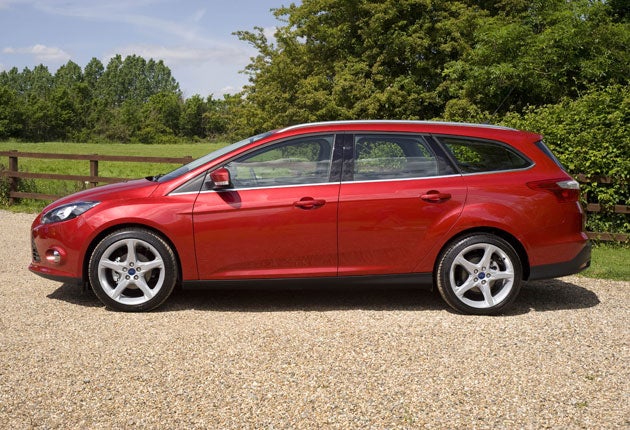Ford Focus Estate
A solid load-lugger, with a few pretensions, has joined the glamorous new generation of Focuses

Your support helps us to tell the story
From reproductive rights to climate change to Big Tech, The Independent is on the ground when the story is developing. Whether it's investigating the financials of Elon Musk's pro-Trump PAC or producing our latest documentary, 'The A Word', which shines a light on the American women fighting for reproductive rights, we know how important it is to parse out the facts from the messaging.
At such a critical moment in US history, we need reporters on the ground. Your donation allows us to keep sending journalists to speak to both sides of the story.
The Independent is trusted by Americans across the entire political spectrum. And unlike many other quality news outlets, we choose not to lock Americans out of our reporting and analysis with paywalls. We believe quality journalism should be available to everyone, paid for by those who can afford it.
Your support makes all the difference.MPVs, SUVs, and combinations of the two, are everywhere.
You could be forgiven for thinking the conventional mass-market estate car is a dying breed, but you'd be wrong. So Ford could hardly not add an estate car to its recently-launched range of third-generation Focuses, if only to stop photocopier salespeople from rioting in the streets.
Up to now this newspaper has sampled only the glamour engines in the new-Focus line-up, specifically the 150 and 182bhp Ecoboost turbo units of 1.6 litres and the 2.0-litre turbodiesel. All are excellent engines but not the stuff of which volume sales are made. This time I have tried the regular, non-turbocharged 1.6 with 125bhp, and the 1.6-litre turbodiesel with 115bhp, on sale now from £18,595. Let's just say that some horses seem less muscular than once they were.
That, however, is to jump ahead. The new Focus, as already tried in hatchback guise, is a good car but slightly disappointing in that, unlike its predecessors, it no longer shines as a beacon of driving enjoyment above a sea of dynamic blandness. Part of the problem lies in the new electrically-assisted steering, which feels fine in the C-Max MPV but has a curiously inert, synthetic response in the hatchback. Then there's the way the dashboard projects so far into the passenger compartment that you feel claustrophobic and the overly fussy styling, and there's the onslaught of "driver assistance" technology.
For the estate car, which has roof rails on all versions to hint better at the strenuous lifestyle the owner must surely lead, the rear suspension has been redesigned to allow a greater width between the rear wheel housings. The redesign also allows a low boot floor, which creates a flat load platform with plenty of space above.
The wheelbase is the same as the hatchback's but the tail is longer, again to the benefit of load space. This is a properly roomy estate car, rather than a "tourer" in which style trumps function. But functionality doesn't mean the rear suspension has to be load-bearingly hard. Rather, the new estate rides gently over bumps.
As for that steering, most drivers will probably have no criticism. Mine exists only because previous Focuses were better. This arguably applies to the 1.6-litre, 125bhp petrol engine, too, because it never feels very keen, especially at low engine speeds in a high gear. Once, 125bhp was a lot of power for a family car, but cars weigh more now so the power doesn't go as far. A 1.6-litre Mark One Focus always felt a lively drive. This one does not.
In a fine illustration of the folly of official CO2 figures and the feather-footed test regime by which they are obtained, this engine is rated at the same 139g/km as the 150 and 182bhp Ecoboost engines. Of course, they probably won't be the same at all, the Ecoboosts using more fuel because you'll be enjoying their easy, lively pace, but if taxation costs are vital to you, then an Ecoboost is a better bet.
Or you could be sensible and opt for the 115bhp TDCi turbodiesel. This ubiquitous engine, found in Fords, Peugeots, Citroëns, Mazdas and Volvos, is a big-hearted little unit with the firm pull from low speeds so lacking in the non-turbo petrol 1.6. This diesel and this Focus are comfortable with each other, and the combination will surely be the most popular of all.
Ford hopes the optional Driver Assistance Pack, at £750 if your Focus is a high-spec Titanium model, £1,000 if a lesser Zetec, will also be popular. I hope it won't be something buyers specify just in case the car is harder to sell without it.
That's because it contains nothing I would want in a new car, apart from a clever system which automatically brakes the Focus if you're about to hit something. But why would I want Lane Departure Warning or Traffic Sign Recognition? Just imagine the beepfest...
The answer is that "premium" cars can have these systems, so it makes the Focus posher. And status, as we know, is all.
The Rivals
Peugeot 308 SW 1.6 e-HDI: from £18,515, 112bhp, 116g/km.
Similar engine and start-stop system to Focus's; awkward tail styling, high-quality interior, pleasant driving.
Vauxhall Astra Sports Tourer 1.7 CDTi 110: from £19,400, 110bhp, 119g/km.
Handsome, with more room than "larger" Vauxhall Insignia S. Good to drive, but too expensive.
Volkswagen Golf Estate 1.6 TDI 105: from £18,970, 105bhp, 119g/km.
There's a "Bluemotion Technology" version with 109g/km, but either way this is a high-quality, useful estate car.
Join our commenting forum
Join thought-provoking conversations, follow other Independent readers and see their replies
Comments